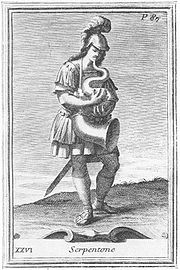
Filippo Bonanni
Encyclopedia

Rome
Rome is the capital of Italy and the country's largest and most populated city and comune, with over 2.7 million residents in . The city is located in the central-western portion of the Italian Peninsula, on the Tiber River within the Lazio region of Italy.Rome's history spans two and a half...
. Among his many works of erudition are the two-volume Numismata Pontificum Romanorum in (1699), and the Gabinetto Armonico in 1723, a splendid collection of 150 engravings of musical instruments from around the world.
Scientific work
Bonanni was an ecclesiastic without true scientific training or experience but he made excellent observations embodied in three works.Ricreatione dell' occhio e della mente.
Bonanni was a shell collector and was the author of the first book devoted solely to seashells, published in Rome in 1681. Several later Linnaean
Linnaean taxonomy
Linnaean taxonomy can mean either of two related concepts:# the particular form of biological classification set up by Carl Linnaeus, as set forth in his Systema Naturæ and subsequent works...
names were based on his illustrations.
Observationes circa Viventia, quae in Rebus non Viventibus
Using a three lens microscope
Microscope
A microscope is an instrument used to see objects that are too small for the naked eye. The science of investigating small objects using such an instrument is called microscopy...
Bonanni tried to show that spontaneous generation
Spontaneous generation
Spontaneous generation or Equivocal generation is an obsolete principle regarding the origin of life from inanimate matter, which held that this process was a commonplace and everyday occurrence, as distinguished from univocal generation, or reproduction from parent...
was possible in animals "without blood and a heart" in contradiction of Francesco Redi
Francesco Redi
Francesco Redi was an Italian physician, naturalist, and poet.-Biography:The son of Gregorio Redi and Cecilia de Ghinci was born in Arezzo on February 18, 1626. After schooling with the Jesuits, he attended the University of Pisa...
’s experimental work. The compilation of knowledge and quality of illustrations made this an important work.
Musaeum Kircherianum, sive Musaeum a P.A. Krichero in Collegio Romano Societatis Jesu... descriptum
In 1698 Bonanni was appointed curator of the well-known cabinet of curiosities
Cabinet of curiosities
A cabinet of curiosities was an encyclopedic collection in Renaissance Europe of types of objects whose categorical boundaries were yet to be defined. They were also known by various names such as Cabinet of Wonder, and in German Kunstkammer or Wunderkammer...
(collection of antiquities) gathered by Athanasius Kircher
Athanasius Kircher
Athanasius Kircher was a 17th century German Jesuit scholar who published around 40 works, most notably in the fields of oriental studies, geology, and medicine...
and lodged in the Jesuit Collegio Romano. He published a catalogue of the collection in 1709 in Rome.

